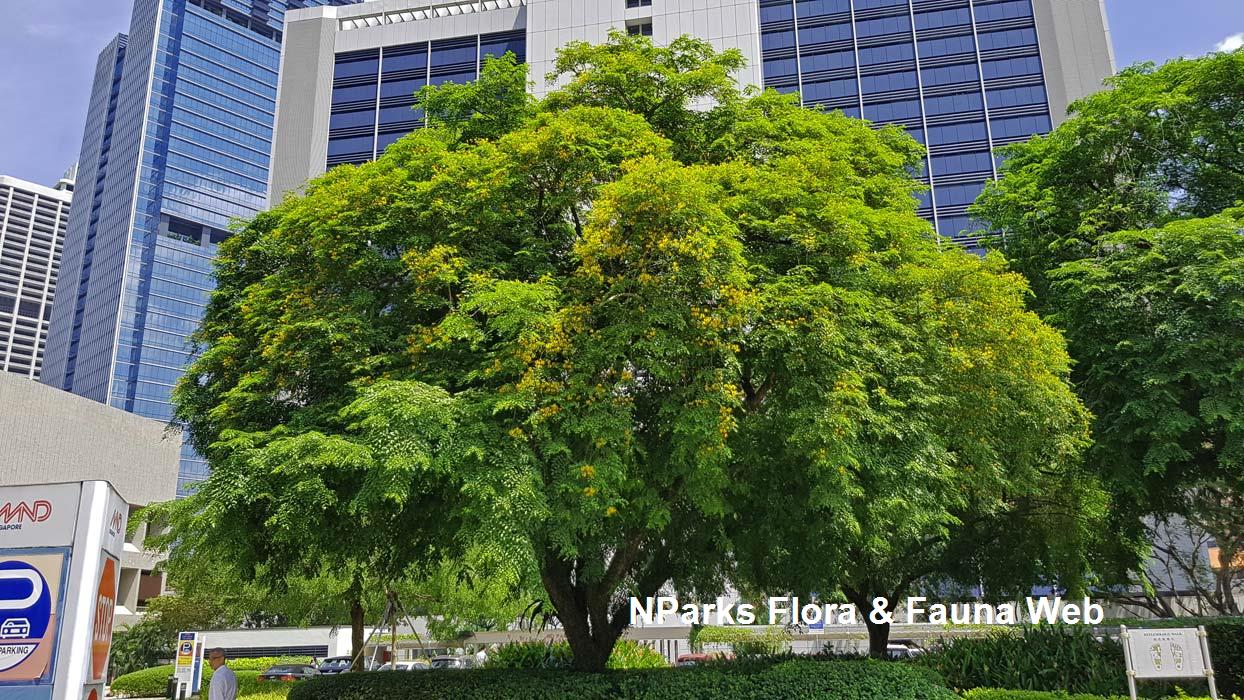_lowres.jpg)
Back
Pterocarpus indicus 'Pendula'
| Family Name: | Fabaceae (Leguminosae) |
| Common Name: | Weeping Angsana, Weeping Rosewood |
Pterocarpus indicus 'Pendula' is a tree, cultivated for its smaller stature and more pendulous branches compared to Pterocarpus indicus. The flowers are bright yellow, fragrant and seldom observed in Singapore.
Name
Classifications and Characteristics
| Plant Division | Angiosperms (Flowering Seed Plants) (Dicotyledon) |
|---|---|
| Plant Growth Form | Tree (Medium (16m-30m)) |
| Lifespan (in Singapore) | Perennial |
| Mode of Nutrition | Autotrophic |
| Plant Shape | Weeping / Pendulous |
| Maximum Plant Spread / Crown Width | 12 m |
Biogeography
| Preferred Climate Zone | Tropical |
|---|---|
| Local Conservation Status |
Description and Ethnobotany
| Growth Form | It is a tree, up to 12 m tall, with spreading dome-shaped crown and drooping branches. It may be deciduous in the monsoonal regions. |
|---|---|
| Foliage | Leaves are odd-pinnate (imparipinnate) and in alternate arrangement. Leaflets are glossy and broadly ovate to elliptic shaped. |
| Flowers | Flowers occurs in a branched cluster (panicle) or a raceme. The flowers are bright yellow, pea-shaped and reportedly fragrant. Flowering is seldom observed in Singapore. |
| Fruit | Fruits have yet to be observed in Singapore. |
| Similar | It is smaller in stature and more pendulous than Pterocarpus indicus |
| Associated Fauna | It is prone to being attacked by leaf-mining caterpillars of a moth (Neolithocolletis pentadesma). |
| Cultivation | Low-branching and pendulous branches can often reach the ground. Prune the branches periodically for pedestrian access or vehicular clearance when needed. It thrives in moist sandy loam or clay loam soil, and can tolerate compacted clayey soils found in urban sites. Like Pterocarpus indicus , it is prone to being attacked by leaf-mining caterpillars of a moth (Neolithocolletis pentadesma). During severe infestation, the leaves may become unsightly and even completely defoliated. The use of systemic soil drench or trunk-injection pesticides may help to control the caterpillar infestation. The tree may also be susceptible to fusarium wilt, caused by the Fusarium oxysporum fungus. |
| Etymology | The genus ‘Pterocarpus’, in Greek, means winged seed. The species epithet 'indicus' refers to India, one of the places where it occurs naturally. |
| Ethnobotanical Uses | Others: The bark may produce red sap when cut. |
Landscaping Features
| Desirable Plant Features | Ornamental Flowers, Ornamental Foliage, Fragrant |
|---|---|
| Landscape Uses | General, Suitable for Roadsides, Shade Providing Tree / Palm |
| Usage Hazard - Cons | Low Crown / Clearance |
Fauna, Pollination and Dispersal
| Fauna Pollination Dispersal Associated Fauna | Caterpillar Moth Food Plant |
|---|
Plant Care and Propagation
| Light Preference | Full Sun |
|---|---|
| Water Preference | Moderate Water |
| Plant Growth Rate | Moderate |
| Rootzone Tolerance | Fertile Loamy Soils, Well-Drained Soils |
| Maintenance Requirements | Moderate |
| Diseases | Like Pterocarpus indicus , it is prone to being attacked by leaf-mining caterpillars of a moth (Neolithocolletis pentadesma). During severe infestation, the leaves may become unsightly and even completely defoliated. The use of systemic soil drench or trunk-injection pesticides may help to control the caterpillar infestation. The tree may also be susceptible to fusarium wilt, caused by the Fusarium oxysporum fungus. |
| Propagation Method | Stem Cutting |
Foliar
| Foliage Retention | Deciduous |
|---|---|
| Mature Foliage Colour(s) | Green |
| Mature Foliage Texture(s) | Smooth, Glossy / Shiny, Thin |
| Foliar Type | Compound (Odd-Pinnate) |
| Foliar Arrangement Along Stem | Alternate |
| Foliar Attachment to Stem | Petiolate |
| Foliar Shape(s) | |
| Foliar Venation | Pinnate / Net |
| Foliar Margin | Entire |
| Foliar Apex - Tip | Acuminate, Mucronate |
| Foliar Base | Rounded / Obtuse, Cuneate |
| Leaf Area Index (LAI) for Green Plot Ratio | 4.0 (Tree - Dense Canopy) |
Non - Foliar and Storage
| Trunk Type (Non Palm) | Woody |
|---|---|
| Mature Bark Texture | Scaly |
| Stem Type & Modification | Woody |
| Root Type | Underground |
Floral (Angiosperm)
| Flower & Plant Sexuality | Bisexual Flowers |
| Flower Colour(s) | Yellow / Golden |
|---|---|
| Flower Texture(s) | Thin |
| Flower Grouping | Cluster / Inflorescence |
| Flower Location | Axillary, Terminal |
| Flower Symmetry | Bilateral |
| Individual Flower Shape | Papilionaceous / Pea-shaped |
| Inflorescence Type | Panicle, Raceme |
| Flowering Period | Rarely |
| Flowering Opening Time | Daytime |
| Flower Lifespan on Plant | 1 Day |
| Flowering Habit | Polycarpic |
Image Repository
Others
| Master ID | 1802 |
|---|---|
| Species ID | 3095 |
| Flora Disclaimer | The information in this website has been compiled from reliable sources, such as reference works on medicinal plants. It is not a substitute for medical advice or treatment and NParks does not purport to provide any medical advice. Readers should always consult his/her physician before using or consuming a plant for medicinal purposes. |

















_lowres.jpg)
_lowres.jpg)
_lowres.jpg)

_lowres.jpg)

